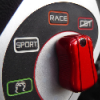is there a way to eliminate the tyre profile size as well , so the data could work for all wheel sizes

Measuring Front Bumpsteer, Wtf
#61

Posted 27 January 2014 - 12:21 PM
#62

Posted 27 January 2014 - 01:50 PM
I've measured using a highly advanced linear measuring device in place of the damper. So the base data is independent of the wheel size. The advanced measuring device is made of an extendable broomstick ![]() . I measure every 10mm from fully extended 340 mm to full depressed 260 mm (and for good measure the last 5 mm to 255 too). My Nitrons are 320mm fully extended and 280 when they touch the bumpstop. So far so good, but you have to translate that into ride height.
. I measure every 10mm from fully extended 340 mm to full depressed 260 mm (and for good measure the last 5 mm to 255 too). My Nitrons are 320mm fully extended and 280 when they touch the bumpstop. So far so good, but you have to translate that into ride height.
First thing is to measure the leverage, which is 1.5. Means 10mm at the damper is 15mm at the wheel. This is as good as linear, so no falling rate at full bump. Next is to relate damper length to hub center height measured from the reference point where you measure the ride height. As all is linear, you can do that by just measuring one point on the damper and translate that to hub height. Eg. 300mm at the damper is 180mm from the center of the hub to the bottom of the car (the rail where you measure ride height from). I've done that in Excel. Then you take the radius of the wheel and from that subtract the 180mm. In my case 297. So ride height is 297-180=117mm. In that case for 115 I only have to correct 2mm or 1.3 at the damper.
I drive 18" (chav, OK) with 215/40's, measured as 615 mm diameter, but actually 297 mm at 1.8 bar on the car. I measured the standard 17" with the standard Bridgestone as 619 mm. So it's actually larger (and a lot heavier).
But , it doesn't matter that much. When you're higher up, in the diagrams, your 0 ride height point moves down: you're OK in general. With smaller diameter wheels, in general you move in that direction. When you want to go lower: it's all dragons from there. You get in all sorts of problems: available bump travel, changing camber, bump steer curves moving in all directions. For my wheels, I think 115 is max. With smaller wheels you can go to 115, but 110 will be pushing it. All very non-exact wording to hide my lack of experience. TBH, I would love to have an adjustable steering arm just to feel how some of this feels in the real world. Some perspective: a 1 degree angle is 8.6 mm in these diagrams.
#63

Posted 27 January 2014 - 04:18 PM
Pretty brilljant stuff here. ![]()
But I'm amazed by how sensitive it reacts on very small height changes. That explains why you can buy about 8 or 9 different height shims for the steering rack.. (another variable that will probably make that curve slightly different)
#64

Posted 27 January 2014 - 05:01 PM
Although I did some calculations first, it was surprising to see it in practice. The one thing to keep in mind is that you have this 1 in 4 leverage of steering arm to rim. So 8 mm at the rim is 2 mm at the arm. And about the height of the rack, it looks like moving it up (so raiser plates installed) brings the pivot point in line with the swing arm. Shimming of the ball joint at the steering arm would take care of the rest. But I can image Lotus/Vauxhall/Opel going for tapered ends and no shimming for long time reliability. On my car at least everything was perfectly tight, after 12 years or so.
For track use, I would move the rack up to bring the pivots as much in line as possible and buy uprights with higher hub placement. I think that's ideal to experiment with. For my use I think I'll go for the EP kit and also experiment a little. Kind of funny to spend 4 days making tools and measuring only to find out that what you need is an off the shelf item ![]()
#65

Posted 27 January 2014 - 05:14 PM
Don't you think that the non adjustable EP arms would be sufficient ? You said that you needed only a few millimeters down
http://www.elisepart...-steering-arms/
Edited by 2-20, 27 January 2014 - 05:16 PM.
#66

Posted 27 January 2014 - 05:48 PM
Although I did some calculations first, it was surprising to see it in practice. The one thing to keep in mind is that you have this 1 in 4 leverage of steering arm to rim. So 8 mm at the rim is 2 mm at the arm. And about the height of the rack, it looks like moving it up (so raiser plates installed) brings the pivot point in line with the swing arm. Shimming of the ball joint at the steering arm would take care of the rest. But I can image Lotus/Vauxhall/Opel going for tapered ends and no shimming for long time reliability. On my car at least everything was perfectly tight, after 12 years or so.
For track use, I would move the rack up to bring the pivots as much in line as possible and buy uprights with higher hub placement. I think that's ideal to experiment with. For my use I think I'll go for the EP kit and also experiment a little. Kind of funny to spend 4 days making tools and measuring only to find out that what you need is an off the shelf item
You mean that will bring it more in line with the upper swing arm, but the vertical upright movement is a combination of both swing arms together and the steering joint center is a bit lower than the upper pivot point. Not much, but we see that you don't need much for big deviations. ![]()
(OEM with -20/30mm raised hubs and maybe -2mm on the steering arm looks to give a nice smooth curve with minimal toe-in in droop.. Hmm, that's just what EP offers with their GT and race uprights)
Question remains how much roll-understeer do you/we need? Seeing all those curves there's only one solution; testing it on road/track... ![]()
#67

Posted 28 January 2014 - 08:51 AM
Don't you think that the non adjustable EP arms would be sufficient ? You said that you needed only a few millimeters down
As Scuffers remarked: define better. In reality I can't as I don't have the experience. I just compared the original front bumpsteer curve with the rear one and thought what the heck. I assume that bumpsteer is like pepper, a little is excellent, but it's quite easy to use a little too much. As I don't have the experience, I want to err on the too little side. For me, the few mm down should be OK. I'm not finished with my car yet however and like to have some adjustability and that's only provided by the EP kit.
#68

Posted 28 January 2014 - 09:02 AM
Although I did some calculations first, it was surprising to see it in practice. The one thing to keep in mind is that you have this 1 in 4 leverage of steering arm to rim. So 8 mm at the rim is 2 mm at the arm. And about the height of the rack, it looks like moving it up (so raiser plates installed) brings the pivot point in line with the swing arm. Shimming of the ball joint at the steering arm would take care of the rest. But I can image Lotus/Vauxhall/Opel going for tapered ends and no shimming for long time reliability. On my car at least everything was perfectly tight, after 12 years or so.
For track use, I would move the rack up to bring the pivots as much in line as possible and buy uprights with higher hub placement. I think that's ideal to experiment with. For my use I think I'll go for the EP kit and also experiment a little. Kind of funny to spend 4 days making tools and measuring only to find out that what you need is an off the shelf item
You mean that will bring it more in line with the upper swing arm, but the vertical upright movement is a combination of both swing arms together and the steering joint center is a bit lower than the upper pivot point. Not much, but we see that you don't need much for big deviations.
(OEM with -20/30mm raised hubs and maybe -2mm on the steering arm looks to give a nice smooth curve with minimal toe-in in droop.. Hmm, that's just what EP offers with their GT and race uprights)
Question remains how much roll-understeer do you/we need? Seeing all those curves there's only one solution; testing it on road/track...
Completely agree. And bumpsteer is not the only thing. I keep on asking about ride frequency (spring rate front an back) as that's another thing that's 'not textbook correct' on these cars. Would be nice to try something like 300F/550R with an adjustable ARB at the front to get the roll balance right front to back. And feel how that drives.
#69

Posted 28 January 2014 - 09:11 AM
I foresee a lot of testing in the near future. ![]()
(If you want to test some springs, I grew quite the collection...)
#70

Posted 28 January 2014 - 09:14 AM
can you imagine rear bump toe-out , hedge-magnet
#71

Posted 28 January 2014 - 10:01 AM
Don't you think that the non adjustable EP arms would be sufficient ? You said that you needed only a few millimeters down
As Scuffers remarked: define better. In reality I can't as I don't have the experience. I just compared the original front bumpsteer curve with the rear one and thought what the heck. I assume that bumpsteer is like pepper, a little is excellent, but it's quite easy to use a little too much. As I don't have the experience, I want to err on the too little side. For me, the few mm down should be OK. I'm not finished with my car yet however and like to have some adjustability and that's only provided by the EP kit.
I see your point . Not sure that the EP kit is the only solution. You could buy the EP rod ends and install them on the OEM forged arms with the right conical washer and flat washers for adjustability. It seems that their rod ends are lower...
#72

Posted 28 January 2014 - 10:08 AM
Completely agree. And bumpsteer is not the only thing. I keep on asking about ride frequency (spring rate front an back) as that's another thing that's 'not textbook correct' on these cars. Would be nice to try something like 300F/550R with an adjustable ARB at the front to get the roll balance right front to back. And feel how that drives.
I will test something similar soon : 375F/525R (but with a lot of weight removed at the back)
#73

Posted 28 January 2014 - 10:15 AM
thats quite a split in rate f/r
#74

Posted 28 January 2014 - 10:23 AM
thats quite a split in rate f/r
As said by alexb , ride frequency is not " textbook correct ", except on the cornering force setup (300/450)
#75

Posted 28 January 2014 - 11:40 AM
#76

Posted 28 January 2014 - 11:51 AM
I run 500 front with 1" arb and its easily the best road manners its ever been.
#77

Posted 28 January 2014 - 11:57 AM
Don't you think that the non adjustable EP arms would be sufficient ? You said that you needed only a few millimeters down
As Scuffers remarked: define better. In reality I can't as I don't have the experience. I just compared the original front bumpsteer curve with the rear one and thought what the heck. I assume that bumpsteer is like pepper, a little is excellent, but it's quite easy to use a little too much. As I don't have the experience, I want to err on the too little side. For me, the few mm down should be OK. I'm not finished with my car yet however and like to have some adjustability and that's only provided by the EP kit.
I see your point . Not sure that the EP kit is the only solution. You could buy the EP rod ends and install them on the OEM forged arms with the right conical washer and flat washers for adjustability. It seems that their rod ends are lower...
Might work, but I think there's not enough elbow room at full bump. The track rods starts to foul steering arm. So you might be able to go down some, but there is a definite limit. From the EP steering arm pictures, it looks like the upper mounting point is in the middle of the steering arm. That would already give you 6 mm minus. TBH, I would be in favour of re-using the forged OEM arm, if only to save some cost. I'm sure it can be done, but to me it looks like one of these things that look quite easy, but where you end up spending more time and effort than it's worth compared to just buying something.
#78

Posted 28 January 2014 - 12:12 PM
Don't you think that the non adjustable EP arms would be sufficient ? You said that you needed only a few millimeters down
As Scuffers remarked: define better. In reality I can't as I don't have the experience. I just compared the original front bumpsteer curve with the rear one and thought what the heck. I assume that bumpsteer is like pepper, a little is excellent, but it's quite easy to use a little too much. As I don't have the experience, I want to err on the too little side. For me, the few mm down should be OK. I'm not finished with my car yet however and like to have some adjustability and that's only provided by the EP kit.
I see your point . Not sure that the EP kit is the only solution. You could buy the EP rod ends and install them on the OEM forged arms with the right conical washer and flat washers for adjustability. It seems that their rod ends are lower...
Might work, but I think there's not enough elbow room at full bump. The track rods starts to foul steering arm. So you might be able to go down some, but there is a definite limit. From the EP steering arm pictures, it looks like the upper mounting point is in the middle of the steering arm. That would already give you 6 mm minus. TBH, I would be in favour of re-using the forged OEM arm, if only to save some cost. I'm sure it can be done, but to me it looks like one of these things that look quite easy, but where you end up spending more time and effort than it's worth compared to just buying something.
You can also mill the forged arm (Remove thickness at the top) and adapt the conical washer. All the lug thickness is not necessary if you see the section where the lug is attached to. But Yes, the kit is certainly less effort for a proven solution.
#79

Posted 28 January 2014 - 12:17 PM
Matt Bently recently commented that 100 to 125 differance front to rear was required on a road setup with a bigger front anti-roll. When I need to referb my Gaz golds I am going for 300 lb front 400 lb rear currently running 375 front 450 rear but I feel the front springs are to hard for our uneven roads.
Higher rate springs certainly make for a harsher ride. The whole frequency thing is more or less specific to road use, as road cars hit more bumps and have less damping. it's to avoid a lot of pitch when the car hits a bump: front first followed by the back. You want the frequency of the back higher by about 10%. it's just a guideline, but it makes perfect sense if you look at the movement of the car. And especially on road, as you have those areas where one bump follows another. I sometimes drive a highway where the bumps are such that at legal speeds, the car hits a resonance frequency and you feel like you sit in a rocking chair. In a normal car much less so, because of the split front/back of ride frequencies.
I've 300 lbs/inch front, 375 back. According to the above with 10% higher at the back, it should be 300F/500B. Based on 270 kgs per wheel rear, 175 kg front and leverage of 1.3 rear, 1.5 front. With 300/400 you almost get the same ride frequency R/F and you can get into that pitching resonance. The standard NA springs are 234F/268R, which calculates to a ride frequency that's actually 10% less at the back instead of more. Now them engineers weren't stupid, so they must have had a reason. But what?
#80

Posted 28 January 2014 - 12:30 PM
Don't forget that you have to use sprung weight only for ride frequecy calculations.
And your own weight too.
Edited by 2-20, 28 January 2014 - 12:31 PM.
1 user(s) are reading this topic
0 members, 1 guests, 0 anonymous users















